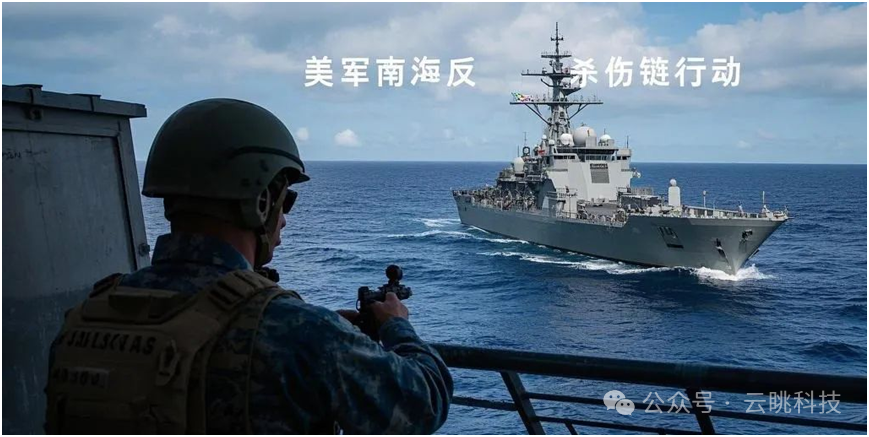Special Report
Ten Special Reports on the U.S. Military’s Anti-Kill Chain Operations in the South China Sea

Title 7. Virtualized Kill Chain: The Technological and Tactical Evolution of the U.S. Military’s Anti-Kill Chain Operations in the South China Sea
Abstract:This study focuses on the technological evolution and tactical application of the virtualized kill chain in the U.S. military’s anti-kill chain operations, detailing how it reshapes enemy reconnaissance and strike chains through data deception techniques. The report begins with the core technologies of the virtual kill chain, analyzing key capabilities such as virtual target generation, dynamic data camouflage, and multi-source signal synthesis, showcasing the innovative breakthroughs in the U.S. military’s operational models. Through case analysis and technical principle dissection, the study evaluates the enhancement of combat effectiveness brought by virtual kill chain technology and its potential to disrupt traditional kill chains, while also providing forward-looking discussions on future technological development directions.
Keywords:Virtualized kill chain; U.S. military anti-kill chain operations; data deception; virtual target generation; dynamic data camouflage; multi-source signal synthesis; tactical deception; information manipulation; intelligent situational awareness; electronic warfare interference; cognitive radio deception; AI-driven battlefield deception; precision strike deception; virtual battlefield reshaping; future operational models
Table of Contents
Chapter 1 The Concept and Development Background of the Virtualized Kill Chain
1.1 The Operational Concept and Technological Evolution of the Virtualized Kill Chain1.1.1 Basic Definition and Operational Logic of the Virtualized Kill Chain1.1.2 Limitations of Traditional Kill Chain Models and Deceptive Improvements1.1.3 Application of the Virtualized Kill Chain in the U.S. Military’s “Anti-Kill Chain” Operations1.1.4 Impact of the Virtualized Kill Chain on Future Operational Systems
1.2 Tactical Objectives and Application Areas of the U.S. Military’s Virtualized Kill Chain1.2.1 The Role of Tactical Deception in Precision Strike Operations1.2.2 Deceptive Interference Patterns in the Reconnaissance-Strike Chain1.2.3 How Data Manipulation Affects Battlefield Situational Awareness1.2.4 Deceptive Tactical Deployments of the U.S. Military in the South China Sea Operations
1.3 Key Technological Elements: From Data Deception to Target Virtualization1.3.1 Core Means of Data Deception and Battlefield Information Manipulation1.3.2 Principles and Implementation of Virtual Target Generation Technology1.3.3 Dynamic Data Camouflage and Multi-Source Signal Synthesis1.3.4 Application of Cognitive Radio in Deceptive Spectrum Control
1.4 Case Analysis of the U.S. Military’s “Anti-Kill Chain” Operations1.4.1 Analysis of Typical Tactical Deception Operations1.4.2 How the U.S. Military Disrupts Enemy Decision-Making through Virtualization1.4.3 Electronic Deception and Multi-Domain Tactical Coordination1.4.4 Evolution of Deceptive Tactics in Future Operational Environments
1.5 Future Technological Development Trends of the Virtualized Kill Chain1.5.1 AI-Enabled Intelligent Deception Systems1.5.2 High-Precision Situational Awareness Deception and Battlefield Camouflage1.5.3 Deep Integration of Electronic Warfare and Information Manipulation1.5.4 Application of Deceptive Tactics in Future Battlefield Operational Systems
Chapter 2 Data Deception and Virtual Target Generation Technology
2.1 Core Technical Principles of Data Deception2.1.1 The Role of Data Deception in Battlefield Environments2.1.2 AI-Assisted Data Deception Techniques2.1.3 The Role of Cognitive Radio Deception in the Virtual Kill Chain2.1.4 Differences between Tactical and Strategic Data Deception
2.2 Key Breakthroughs in Virtual Target Generation Technology2.2.1 Multi-Dimensional Target Simulation and Sensor Deception2.2.2 Behavior Simulation and Dynamic Adjustment of Virtual Targets2.2.3 Tactical Combination of Electronic Deception and Camouflaged Targets2.2.4 Tactical Use of Virtual Targets in Future Battlefield Environments
2.3 Technical System of Dynamic Data Camouflage2.3.1 Methodology of Real-Time Battlefield Data Camouflage2.3.2 Cognitive Interference and Situational Deception Systems2.3.3 AI-Enabled Data Camouflage Technologies2.3.4 Development Directions of Deception Systems in Future Battlefields
2.4 Multi-Source Signal Synthesis and Deceptive Information Fusion2.4.1 The Role of Multi-Source Data Fusion in Information Deception2.4.2 Virtual Signal Generation and Deceptive Situational Control2.4.3 Strategies for Combining Electronic Deception Signals and Communication Interference2.4.4 Future Development Trends of Multi-Source Data Deception in the U.S. Military
2.5 Application Prospects of Virtual Target Technology in Future Battlefields2.5.1 Challenges and Opportunities of Intelligent Battlefield Deception Systems2.5.2 Deceptive Applications in Future Precision Strike Tactics2.5.3 Coordinated Development Directions of Electronic Warfare and Data Deception2.5.4 China’s Response Strategies in the Field of Virtualized Kill Chains
Chapter 3 Deep Integration of Electronic Warfare and Cognitive Radio Deception
3.1 Application Models of Electronic Warfare in the Virtualized Kill Chain3.2 Core Technologies and Tactical Value of Cognitive Radio Deception3.3 Spectrum Control and Interference Signal Generation Technologies3.4 Application of Electronic Warfare Deception in Unmanned Systems3.5 Integration Strategies of Electronic Warfare and Deceptive Battlefield Intelligence
Chapter 4 AI-Enabled Virtualized Tactical Deception Systems
4.1 AI‘s Role and Development Trends in Data Deception4.2 Machine Learning-Driven Deceptive Target Optimization and Adjustment4.3 AI-Assisted Cognitive Deception and False Information Manipulation4.4 Automatic Adaptability and Challenges of Intelligent Deception Systems4.5 Future Evolution of Battlefield Deception Technologies Led by AI
Chapter 5 Impact of the Virtualized Kill Chain on Future Operational Systems
5.1 How the Virtualized Kill Chain Changes Future Operational Models5.2 Impact of Battlefield Deception Technologies on Precision Strike Capabilities5.3 How Intelligent Deception Technologies Shape Multi-Domain Battlefield Environments5.4 Adaptability and Challenges of Deceptive Operations in Future Warfare5.5 China’s Technological Layout and Development Strategies in the Field of Virtual Kill Chains
Chapter 6 Development Path of Intelligent Deceptive Tactics in Future Warfare
6.1 Systematic Construction of Advanced Situational Awareness Deception6.2 The Role of Battlefield Deception in Future Intelligent Warfare6.3 Deep Integration of Cognitive Warfare and Data Deception6.4 Automation Development Trends of Deception Technologies in Future Battlefields6.5 Development Directions and Defense Strategies of Anti-Deception Technologies
